Our publishing staff visited the firm based in Caerano di San Marco (Treviso province), showing special interest in the safety department, as the latter registered a double-digit growth in 2021. Enrico Moretti Polegato, Chairman, and Giorgio Pira, Global Sales Director, outlined the overall picture
Last summer, the staff of the “Safety” magazine, printed by the Milan-based publishing house Mpa Style, spent a whole day at the Diadora facility in Caerano di San Marco (Treviso province), showing a specific interest in the safety department, represented by the Utility division. The following article features the statements of the firm’s chairman, Enrico Moretti Polegato, – who welcomed us in the corporate showroom, amid huge posters portraying all the champions who have used Diadora models -, as well as of the Global Sales Director, Giorgio Pira. The other three articles, on the other hand, include the interviews to, respectively, Cristian Ardissono (Product Manager Utility Footwear), Mauro Baccega (Operations Manager Footwear Europe), and Michele Risatti (R&D & Quality Manager), the latter in charge of the Laboratory, each focusing on specific activities.
Diadora was established in 1948, starting off as a workshop specialized in the making of handcrafted mountain and work boots, quickly growing into one of the best manufacturers on the market. Fifty years later, in 1998, a new intuition allowed Diadora to take advantage of the experience acquired in the sports sector and to go somehow back to roots via a renewed interest in work shoes: hence the launch of Diadora Utility, that is, the go-to footwear and apparel brand for the safety market – technology, top-notch quality standards and a sporty style create the perfect combination, leading to unparalleled models. This was the starting point of a strategic, ongoing timeline, a byword for innovation design-wise as well as from a technological perspective.
2005 marked the debut of Glove, the first safety shoe standing out for its style and linear design, developed to blend lifestyle and the sports world. Functional and casual at the same time, thanks to these characteristics, Glove has turned into Diadora Utility’s iconic model. 2003 featured the presentation of the ground-breaking Net Breathing System by Geox patent: with the Jet collection, Diadora Utility became the first and only company operating in the safety sector to own this breathability system and to use it in its products. The same technology was then implemented, in 2020, by the Airbox system, an innovation patented by Diadora Lab, a topic we will deal with later on. As for 2021, the firm launched another cutting-edge solution: Glove Eco, that is, the first safety shoe specifically conceived to protect workers’ health as well as to safeguard the environment. It is made with partially recycled materials that fully comply with specific environmental and social criteria within the production chain, a testimony to the company’s steady drive to a more sustainable future.
At Diadora Utility, preparations are well underway for the upcoming 25th anniversary, scheduled in 2023: a milestone marked by a constant growth both in terms of turnover and when it comes to the range of new technologies provided.
“Diadora Utility,” stated Enrico Moretti Polegato, chairman, “plays a key role for our group. For over seventy years, Diadora has been acknowledged as one of the most prominent brands in Italy with regard to sports products. The valuable experience gained in sport, a sector in which we have managed to combine excellent performances, comfort, safety and aesthetic care, led us, in 1998, to invest in the safety world as well, thus imbuing our articles with the whole technological innovation previously implemented in sports footwear. A successful insight: Utility experienced a double-digit growth in 2022, a trend set to repeat itself in 2022 too. We will keep investing, as confirmed by the decision to relocate part of the production back to Italy. We believe in the brand and in its Italian identity.”
We then proceeded to ask to the firm’s chairman how Diadora succeeded in paving the way to innovation in the safety sector. “Utility work shoes,” added Enrico Moretti Polegato, “are the only one that can make full use of Diadora’s research and innovation previously applied to sports footwear. Moreover, ours is an Italian enterprise and we develop models that, even design- and comfort-wise, stand up to any challenge. In line with our sporty core, in the past year, we launched Fly, that is, the most lightweight safety shoe currently available on the market, weighing slightly more than 300 grams. The result of steady investments in the R&D segment, a department supported by an amazing team that has carried out impossible tasks, thanks also to the collaboration with Geox.”
Together with Giorgio Pira, Utility Global Sales Director, we analysed Diadora’s response, even in terms of investments, to the labour market recovery. “Generally speaking, technical and product innovation is of primary importance for the safety footwear world. As a matter of fact, Diadora has been always investing significant resources in its R&D laboratory, recently expanded. It is equipped with several machines, a feat that allows us to develop increasingly cutting-edge technologies as well as to further improve our articles’ first-rate quality standards. In this way, we can effectively meet both the workers’ demands and the consumers’ different needs. For us, innovation plays a key role not only because it helps us keep abreast of the times, but also because it is, together with sporty design, our distinctive trait. One of the best results ever achieved by Diadora lies in the development of Airbox, namely, the breathability technology that brings together side holes and the membrane patented by Geox. Therefore, this system guarantees the utmost breathability for the foot and the complete balance with the protection elements inside the shoe. During the current season, we have launched the Shark line provided with the “Stable Impact System”, a new technology developed and filed for patent by Diadora, able to ensure top-notch comfort and reactivity, resulting in stable, even cushioning effect regardless of the amount of force applied.”
Another interesting topic concerns the users Utility addresses with its range of PPEs (Personal Protection Equipment), together with the market feedback. “Diadora Utility,” stated the Global Sales Director, “turns its attention to different categories of workers, providing them with a comprehensive product catalogue so as to meet the most varied requirements. Our core business comprises craftspeople, plant engineers and all those professionals who choose their PPEs according not only to protection properties, but also to the performance criteria. In other words, workers who consider their PPE in the same way as any other work tool and who, consequently, are on the lookout for high-level comfort, technology and design standards. We also deal with the industry and logistics world via the development of specific articles, in line with the demands of said professionals. Furthermore, the catalogue features product categories conceived to fulfil the needs of workers operating in outdoor contexts such as the construction industry, gardening and agriculture.”
“Over the last two years,” explained Giorgio Pira, “the market has experienced a positive fluctuation, fostered by PPEs for Covid-19 protection and by the incentives for the construction sector, as confirmed by the increasingly strict regulations for construction sites. Today, workers’ risk awareness is way higher, hence the constant attention to personal safety. At the same time, we have noticed that enterprises are steadily on the lookout for reliable, honest partners. The balance between these factors contributes to the success of both the company and the brand.”
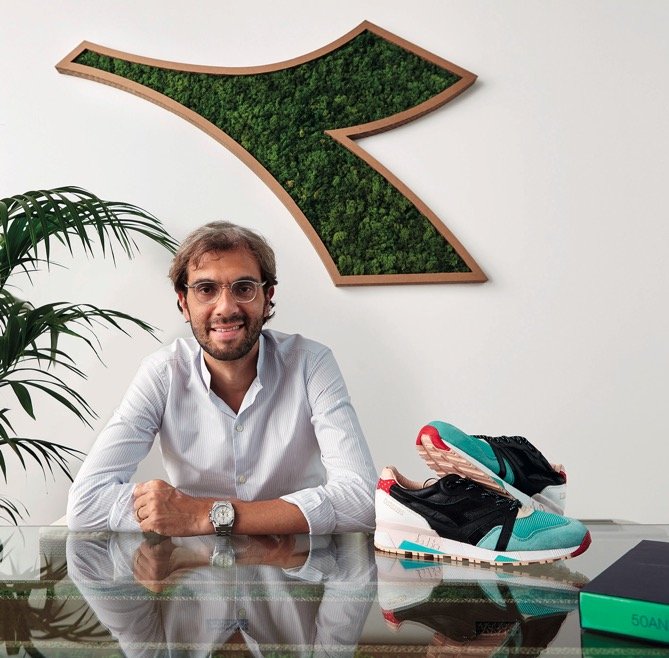
Enrico Moretti Polegato, Diadora President’s
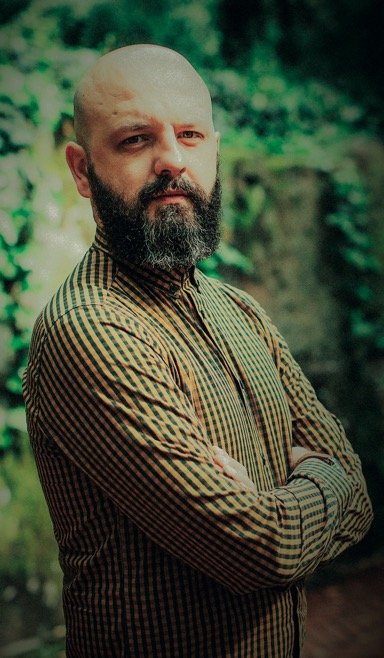
Giorgio Pira, Global Sales Director Utility
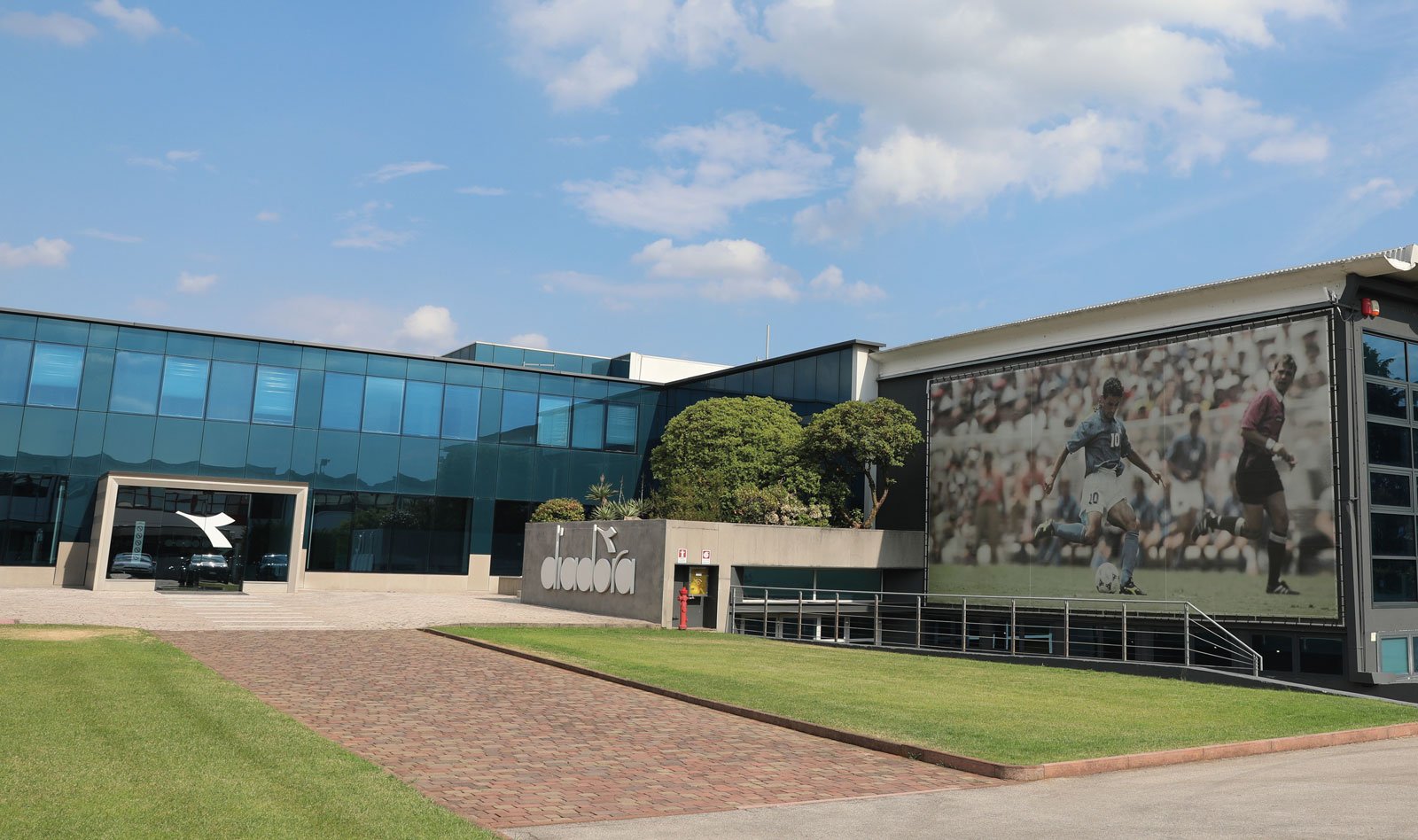
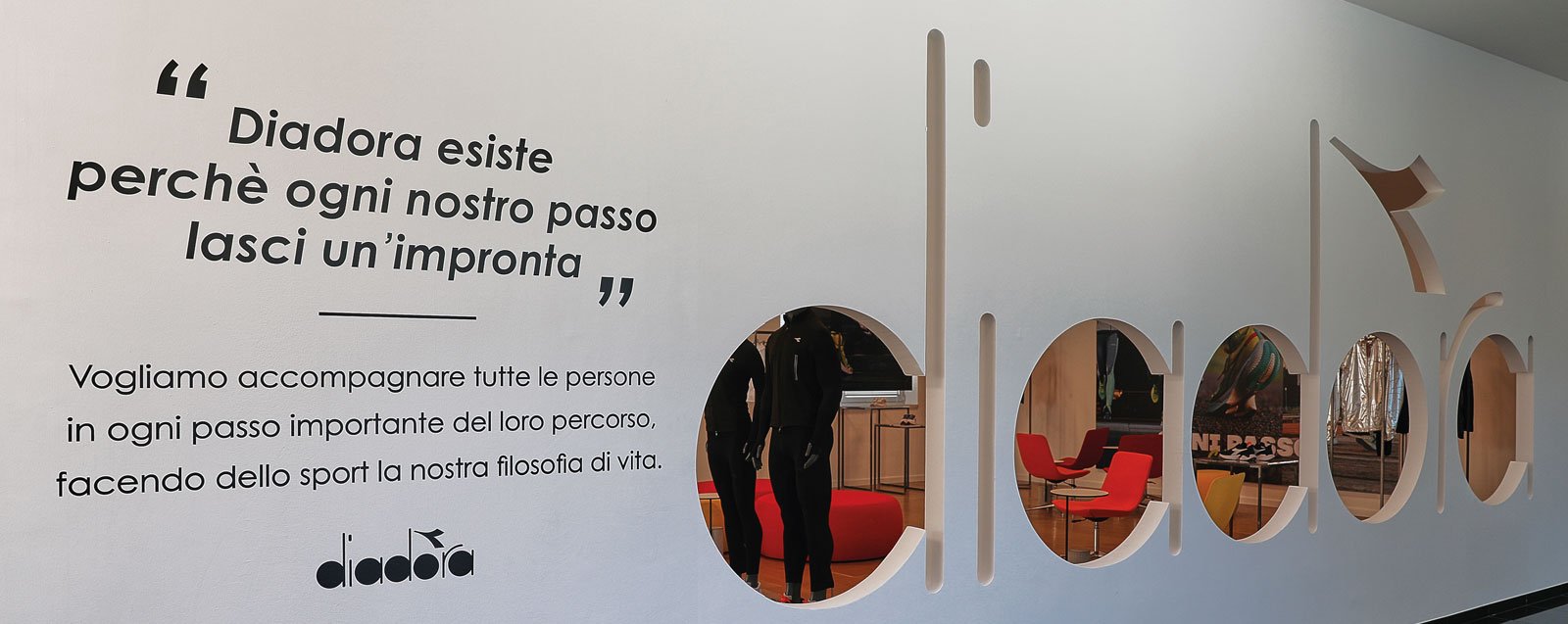
The Diadora’s headquarter in Caerano di San Marco (Treviso)

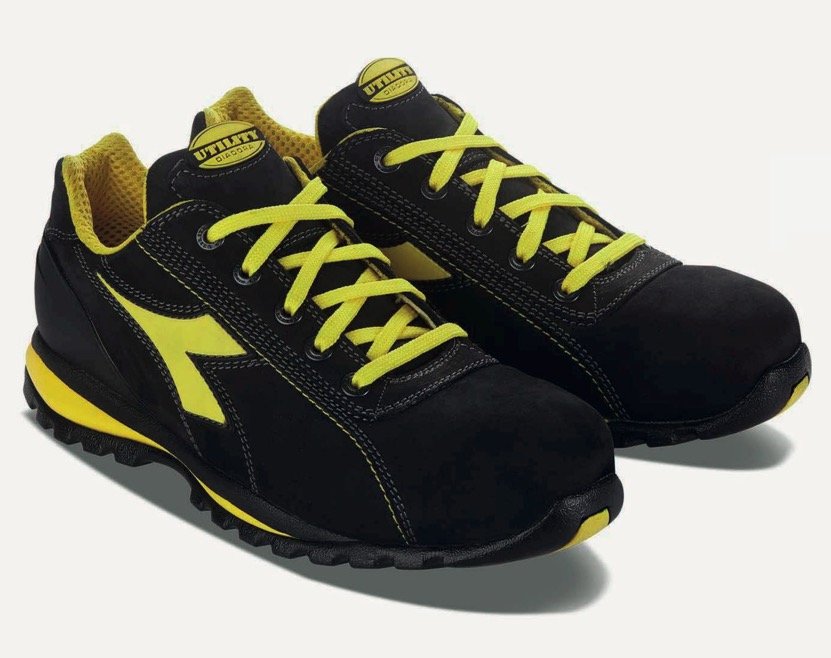
The Iconic Diadora Utility model, “Glove”, featuring the typical black and yellow 00
Diadora Utility, a brand rooted in the sports world
Cristian Ardissono, design manager, explained the brand’s leadership in the safety field as well as the breakthroughs experienced in the 2000s
“Our safety shoes stand out for their sporty core, both aesthetically and from a technical point of view. It is a pivotal, distinctive trait.” Cristian Ardissono, Product Manager Utility Footwear, introduced us to the world of Diadora Utility, when we interviewed him during our visit at the corporate premises. “In the DNA of our company,” stated Ardissono, “safety and performance are a true must, an asset when it comes to product design, in full compliance with regulations. I can proudly claim that Utility is the only safety brand grounded in the sports world. This has always been Diadora Utility’s signature feature. Today, sport design is a well- established trend: Diadora boasts a wealth of experience acquired in over seventy years in the business, years marked by tests, competitions, results achieved together with athletes grown into sports legends. Steady research has led both to the solution of individual athletes’ issues and to improvements performance-wise. Innovation is part of Diadora’s history, ranging from soccer to running, up to tennis. Said expertise has been applied to safety footwear.”
At this stage, what are the strategic features to develop and manufacture a safety shoe?
“Sports performance-related stress is often concentrated in a brief period of time. Safety footwear must protect, be comfortable and high-performance even for 10-12 hours a day. A worker, for instance, operating in the construction industry, leaves at 7 am and gets back, more often than not, at the same hour in the evening, always wearing the same shoes. Our mission lies in providing an article than can guarantee, first and foremost, protection, while paying close attention to lightness and breathability as well. The latter is one of our main clouds during the design phase, highlighted primarily by the Net Breathing System by Geox technology. As for product design, I think that those wearing safety footwear should feel comfortable with the shoes they wear outside the professional context. Nowadays, “sneakers” are the most popular model, no longer chosen solely by teenagers and kids. Sport design has always been a distinctive feature of Utility footwear. Generally speaking, safety shoes design is heading down in this direction.”
Diadora Utility, in balance between comfortable shoes and regulatory constraints: what is your formula for success?
“With regard to product design, Diadora Utility always aims for performance improvement, in full compliance with regulatory constraints, raising the bar higher and higher. By giving definite standards concerning a topical issue, the whole R&D team can focus on the reduction of weight and volumes. On the one hand, the ongoing search for new materials and articles and, on the other, the design and testing of solutions conceived to decrease, even slightly, the weight of the single components. A lesson taken from the sports world, where details make the difference between victory and defeat. Approximately fifteen years ago, a safety shoe weighed on average from 600 to 800 grams; today, said weight has been almost halved. For example, weight-wise, our FLY model can be compared to a running shoe, from a stylistic point of view as well.”
And what about the second factor?
“Regulations play a key role: we might have had the chance to design and produce a lightweight safety, even lighter than FLY, but protection is of primary importance. A sole made with a material provided by VIBRAM, nitrile rubber, ensuring the utmost slip resistance standards, the high-tenacity technical fabric MATRYX, a TPU protection for the toes. Without forgetting the use of carbon fibre for the making of the toe-cap. The ultimate goal is to guarantee top-notch protection levels in most professional contexts. Before the launch of the Utility brand, safety footwear looked like hiking boots, heavy and black. Diadora has managed to utterly change work shoes, both from a technical and an aesthetic point of view. It is no surprise that the majority of our competitors has chosen to follow our path.”
Concerning the safety sector, what are your reference end markets?
“Our key market is western Europe, where we have gained a strong foothold not only in the domestic market, but also in France and Belgium. In the last few years, we have registered a significant growth in Spain, Germany and the Netherlands. Besides Western Europe, we sell our products in the Eastern side of the continent as well and, more in general, to countries that accept EC regulations. In Australia and Japan, we can rely on licensees, who develop collections and models in close contact with Italy; in that way, quality standards and brand perception are perfectly in line with the overall strategic perspective.”
As for the Utility brand, what are the main innovations launched in 2022?
“Last March, we presented the Shark line, thus launching on the market the so-called Stable Impact System technology: namely, direct injection footwear featuring excellent shock-absorbing properties, a feat resulting in top-notch comfort and cushioning levels regardless of the amount of force applied. Thanks to this technology, we have managed, via the study and design of the sole’s geometries, to provide the same shock-absorbing effect to everybody, whether they weigh 70kg or 120kg. The same goes for other technologies too. Diadora has been working for over two years for this patent’s research and development, and, now, we are reaping the first satisfying results sales- wise. Equally positive the users’ feedback, thanks to an effective, successful solution, as it helps cushion shocks and keep in check the workers’ weight. “Wow, this is the most comfortable shoe I have ever worn”: when the design group gets this type of feedback, it is the peak of satisfaction for us. Moreover, we have expanded the Run Net Airbox line, that is, the models featuring side breathability, launched in 2020. Over the last three years, we have focused, in succession, on breathability, lightness and cushioning.”
What are the projects scheduled for next year, even in terms of sustainability?
“There will be some significant innovations. We will keep working on a cloud that, at the moment, I can’t reveal, but it will be an essential tool to help us change the game and its rules. On a global level, labour market has been recovering and PPEs are in high demand. In the past decade, safety shoes have experienced a true breakthrough in all respects. Construction sites and, in general, professional environments are fully regulated. As for sustainability, Glove Eco is our flagship, the best example of Diadora Utility’s commitment to this topic, not only when it comes to the use of recycled materials, but also for the compliance with environmental and social parameters within the production chain as well as with the Recycled Claim Standard (RCS). A shoe conceived, designed and manufacture inside Diadora’s conveyor area. The Eco version, absolutely identical to the iconic Glove model in terms of design and performance levels, puts in the limelight the efforts made by our company sustainability-wise. The rubber used for the sole is in part recycled and in part devulcanized. The same goes for the insole, the upper and the toe-cap. A design cycle that entails the thorough testing of all materials and components, including water-based adhesives and the laces’ extremities.”
Diadora Utility does not provide solely footwear…
“Exactly, there is an ample range of workwear solutions, perfect to meet all requirements. Our key users are craftsmen, who go to the store and pick the most suitable items of clothing based on their specific needs, comfort levels as well as on style and colours. Furthermore, there are garments designed for the industry sector, that are incredibly functional and that can be combined so as to create uniforms. If need be, the latter can be customized with corporate logos. The Diadora Utility collection is the result of the steady search for cutting-edge technologies and materials, of studies concerning movements’ ergonomics and apparel functionality, in order to constantly improve comfort standards, while guaranteeing a modern, eye-catching style. Among the technologies that distinguish Diadora Utility workwear, a special mention goes to the Breathing System, that is, a breathability system patented by Geox, used on a few selected garments. As it happens with shoes, it helps keep body temperature stable. In this way, water vapour can get out and the body is always dry.”
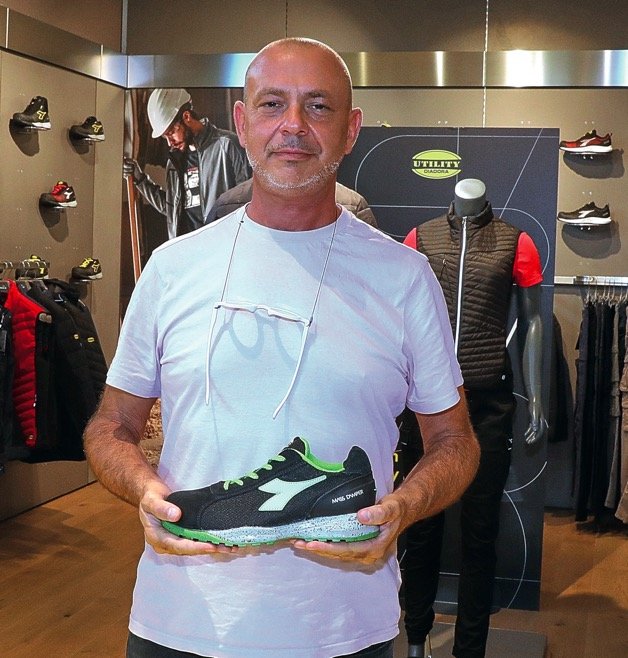
Cristian Ardissono, Product Manager
Conveyor systems: where products come alive
Mauro Baccega explained the secrets of the Diadora facility, the latter playing a strategic role for the Veneto- based enterprise, revived in 2015 after a long period of inactivity
Diadora’s conveyor systems – back to active production in 2015, after fifteen years of downtime – are one of the most prominent strategic areas for the development and making of footwear, a true asset for the firm headquartered in Caerano di San Marco (Treviso province), supporter of a craftsmanship-oriented manufacturing tradition. Mauro Baccega, Operations Manager Footwear Europe, welcomed us during our visit: he outlined in detail the various production phases carried out in a well-organized facility.
“The in-house conveyor area,” explained Baccega, who started off with a general overview, later moving on to the various operations, “is used to develop the first prototypes. As far as Utility is concerned, the process is longer and thorough, so much so that a model requires several quality tests to achieve the necessary compliance certifications before actual manufacturing. The product division takes care of the design, as technicians analyze and choose both colours and materials. Inside the facility, we can rely almost exclusively on craftsmen, between 7 and 8 units, given that the majority of the operations are carried out by hand and, for the most part, machines are managed manually. Said machines are the very same installed back in the ‘70s and ‘80s, already used by the previous owners: left unused for years, they have been switched on once again, while, in the meantime, other tools and equipment have been added so as to carry out the whole production cycle. Modern, automatic machinery would have never resulted in craftsmanship and quality control procedures, both guaranteed by our work method, piece by piece.”
While holding a shoe, Baccega focused on the explanations of the operations carried out throughout a definite process, even though the latter is not an assembly line. “The first safety shoe developed by Diadora Utility dates back to 1998 and it featured a dark colour, either black or brown. New projects fostered in- house led, in 2005, to the launch of Glove, that is, the iconic Utility model, a breakthrough as far as the safety market is concerned. Since then, we have witnessed a true revolution, as confirmed by a steady growth and improvement from several points of view, from design to comfort. The combination with the sports world has resulted in the first safety shoe that does not look like a boot. Quite the contrary. Thanks to a constant commitment to study, research and development, said model is more similar to sporty footwear. Besides style and design, special attention has been paid to comfort, given that safety shoes are worn, on average, 9-10 hours a day. For this reason, Glove turned out to be a revolutionary article.”
The production cycle kicks off upon the arrival of the design in the conveyor area. “Since it is a new article,” added the Baccega, “the first step lies in cutting the pieces according to the colours and leathers chosen by the product manager, later handed to the hemming machine, tasked with uniting them to manufacture the upper. Once this phase is completed, the actual production cycle can begin: the first activity, in view of anti- crushing protection, concerns the addition of a toe-cap, available in steel, aluminium, carbon and glass fibre. The next operation is carried out by the so-called “pulling over lasting” machine, so as to assembly the toe-cap with the last. Regarding Utility, the number of products processed daily in the Diadora conveyor area is not huge: the manual control of every single piece bears witness to the meticulous cycle and the top-notch quality of each model. “On average, we manufacture 90-100 pairs of safety shoes per day, a limited, yet necessary quantity to perform a double passage in the conveyor area. However, there is no secret: in other words, it is a procedure for the making of classic, handmade shoes with the addition of a toe-cap.”
Step by step, Mauro Baccega explained all the phases leading up to the production of the finished shoe, ready to be stored and shipped. “After closing the front part, an operation carried out by a specific machine, we then proceed to seal sides and heel, a process that can also be manual, as it does not require the use of special machinery. The next step lies in the removal, with a brush featuring sandpaper, of the surplus material of the upper assembled onto the last. Said activity contributes to the effective penetration of glue: in this way, the sole fits perfectly. On each upper, we mark the place where the sole is applied: after that, it is time to use an adhesive tape, that will be removed to facilitate the work of the technician tasked with applying the glue. After the first layer on the upper, it is necessary to wait for 20-25 minutes, hence the decision to hang on the wall a few clocks to mark time. The second glue layer is applied to the upper and the sole, followed by another 20–25-minute break. After these pauses, the technicians “re-activate” the mastic of both components by placing upper and sole in an oven at a controlled temperature. We then proceed with the press machine, two times, so as to guarantee that sole and upper fit without problems. Afterwards, the shoe is placed inside a fridge for a limited amount of time, just a few seconds: at the end of the cycle, the mastic is stable, molecules are no longer working and it is possible to remove the last from the shoe because the sole is perfectly glued. By this point, it is time to focus on finishing processes, including the addition of the lace and of the insole, the application of ribs, as well the removal of any processing residues. The last stage revolves around quality inspections, carried out by hand through several measurements and tests. Only then, the pair of shoes is placed in a box and sent to the finished product warehouse, ready to be shipped.”
Lab, at the core of Diadora Utility’s R&D
Manager Michele Risatti explained the pivotal role played by the laboratory, grown into a state-of-the-art testing centre equipped with cutting-edge machines, some even custom-made
Astrategic area for Diadora, inside the corporate headquarters in Caerano di San Marco (Treviso province): the Laboratory, better known as Lab, was an interesting part of our visit. Manager Michele Risatti (R&D & Quality Manager), who joined the Veneto-based firm back in 2005, welcomed us and explained in detail the functions of the tools as well as the activities carried out daily.
“Since its foundation in 1948,” stated Michele Risatti, “and up until the 80s, Diadora, due to its significant production, had always owned efficient laboratories for the physical-mechanical testing of both materials and finished articles. For some years, we have been relying on third-party contractors as well, but the R&D phase, up until the final stage, is fully monitored in-house. As for safety footwear, the corporate strategy is clear: the addition of a new product must result in top-notch quality standards in full compliance with the current PPEs regulations, the latter established internationally.”
Since the ‘80s, what has changed?
“Concerning R&D activities, since the ‘80s, the enterprise has chosen an innovative approach. We are referring to the opening of CRD, that is, Centro Ricerche Diadora (Diadora Research Centre, editor’s note), a facility boasting a multidisciplinary team that brought together three “souls”: doctors, bioengineers, and footwear technicians. Said professionals, who supported first and foremost Diadora’s great athletes, were tasked with checking end products to ascertain the presence of three pivotal characteristics: safety, comfort, and reliability. Even today, we still rely on our technicians as well as on partnerships with prominent research institutions so as to develop cutting-edge solutions for both the safety and sports sector.”
What can you tell us about the current structure of your laboratory?
“The original values are still valid, but, in the last few years, we have taken a further step forward, since the laboratory has become a true R&D department: its task lies not only in checking the physical and mechanical properties of materials, but also their “behaviour”, once turned into finished products, in relation to the end user, and other characteristics such as dynamic aging. With regard to these modern, sophisticated activities, applied to both running and safety models, we have established renowned collaborations with the Biomechanics Institute in Valencia (Spain) and with the UW School of Medicine (Washington, D.C., the USA).”
As for product development, how has the vast experience acquired in different sectors helped you?
“In the 2000s, we managed, thanks to our skills and to a bit of good fortune, to apply the technologies and expertise acquired in the sports world to the safety sector. The reverse happened as well: safety models ensured such high performance levels that they were implemented in sporty lines too. The primary goal is to differentiate articles according to specific individual demands. After all, consumers pick the solutions that suit them best.”
What are the procedures carried out in the laboratory?
“We analyse each single material we receive, generally from the Production or from the Product divisions, such as hides and fabrics. For the Utility world, since it is necessary to assess the features of leathers and other elements used for the making of the PPEs, we must check their compliance to reference regulation, not only to our quality standards. A double check is required before kicking off actual the actual manufacturing process. Said materials undergo several tests, well-defined in terms of values and duration, including, just to name a few, tensile strength, adhesion strength and tear resistance. The data acquired are registered in a database and we eventually draw up a report containing information about a specific material and its physical-mechanical strength.”
What are the tools you use the most?
“Among all the tools and equipment at our disposal, a special mention goes to the hydrometer, as it plays an important role for Diadora products: the sole, featuring a tread and a midsole (the part placed between the upper and the tread), can account for a 60-70% share of the shoe’s final weight when it comes to running models, and for 50% in case of Utility articles. For this reason, it is of primary importance to measure in a consistent way the density of the sole’s materials. The procedure is fairly simple: the product is put on the sample holder and, with a pharmaceutical scale, able to weigh an item down to the thousandth of a gram, we define its mass. As for the measurement of volume, we resort to the classic Archimedes’ principle, thus placing the sample into a water-filled container.”
What can you tell us about the other pivotal machines Diadora Lab is equipped with?
“We can rely on an ample array of machines, divided by type so as to effectively perform tests on leathers, fabrics or rubbers. Thanks to a UV lamp, we can use ultraviolet rays on materials to check their yellowing resistance levels. We have equipment to carry out some bending tests on finished products as well, with option of increasing the frequency: as in the case, for example, of walking simulators that allows us to ascertain whether a shoe’s structure is perfectly compliant and correct. We also own several abrasion testers, employed mainly in the safety sector, given that the measurement of the abrasion of the upper and of the toe-cap is of primary importance in said field. On the other hand, the Bally flexometer is a machine that helps simulate the bend of the tray: if the sample does not break after a specific amount of bending tests, the likelihood of that happening in real life is almost non-existent. With regard to the safety world, another pivotal tool is the so-called Martindale, required by internationally recognized regulations: it simulates random movements of elbows, knees and heels on the lining; the material under examination must pass resistance tests by undergoing a given number of dry cycles as well in wet conditions.”
Another group of machines comprises equipment built in-house, is it correct?
“The machines mentioned before have been purchased from companies specialized in their production and sale. When it comes to the equipment entirely developed by Diadora, together with reliable mechanical workshops, we should name two in particular. The former is called “Marathon”, given that it simulates the dynamic aging of product caused maybe by a run or by a stroll: ranging from standard materials up to more flexible and reactive options, we can measure the decay rate of elasticity-related performances. Among the data provided by the machine after a number of cycles, there are the evolution of material deformation over time as well as applied load curves. The latter’s name is “Race”, designed to define the elasticity and/or absorption properties of both materials and shoes. More specifically, we have developed a pendulum featuring three arms: one is straight and is used to test the material as it is; on the second arm, we load the shoe that puts pressure on the heel, while the third one is where we place the shoe so that it might be able to put some strain on the forefoot. This is a pivotal tool for both running and safety footwear, because it helps highlight the difference between the data concerning the heel and those related to the forefoot, that is the two areas undergoing the highest strain in terms of shock-absorbing properties and of plantar pressure distribution.”
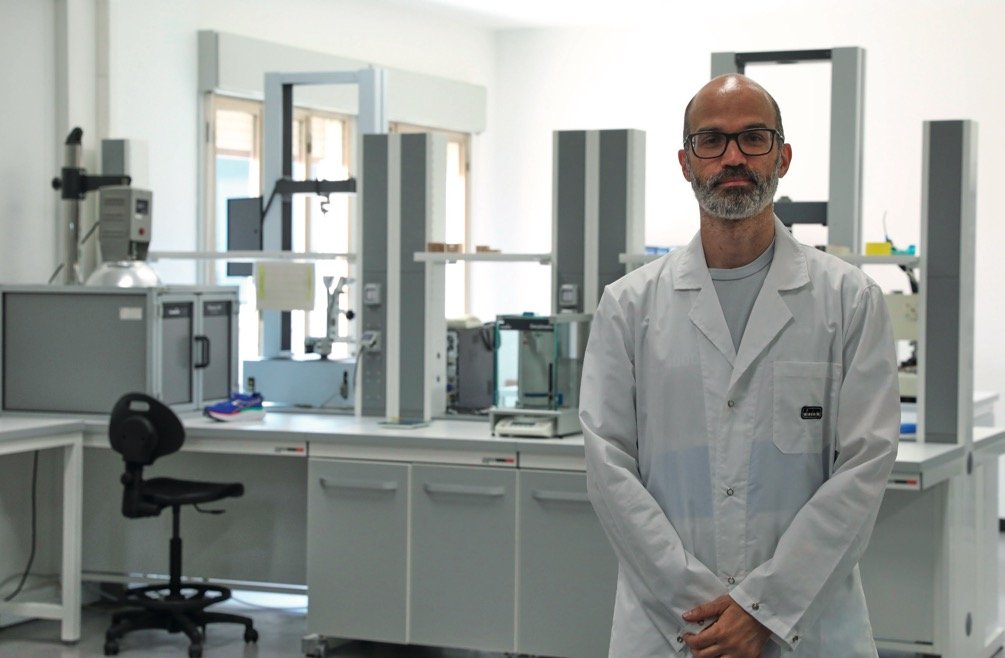
Michele Risatti, R&D & Quality Manager
